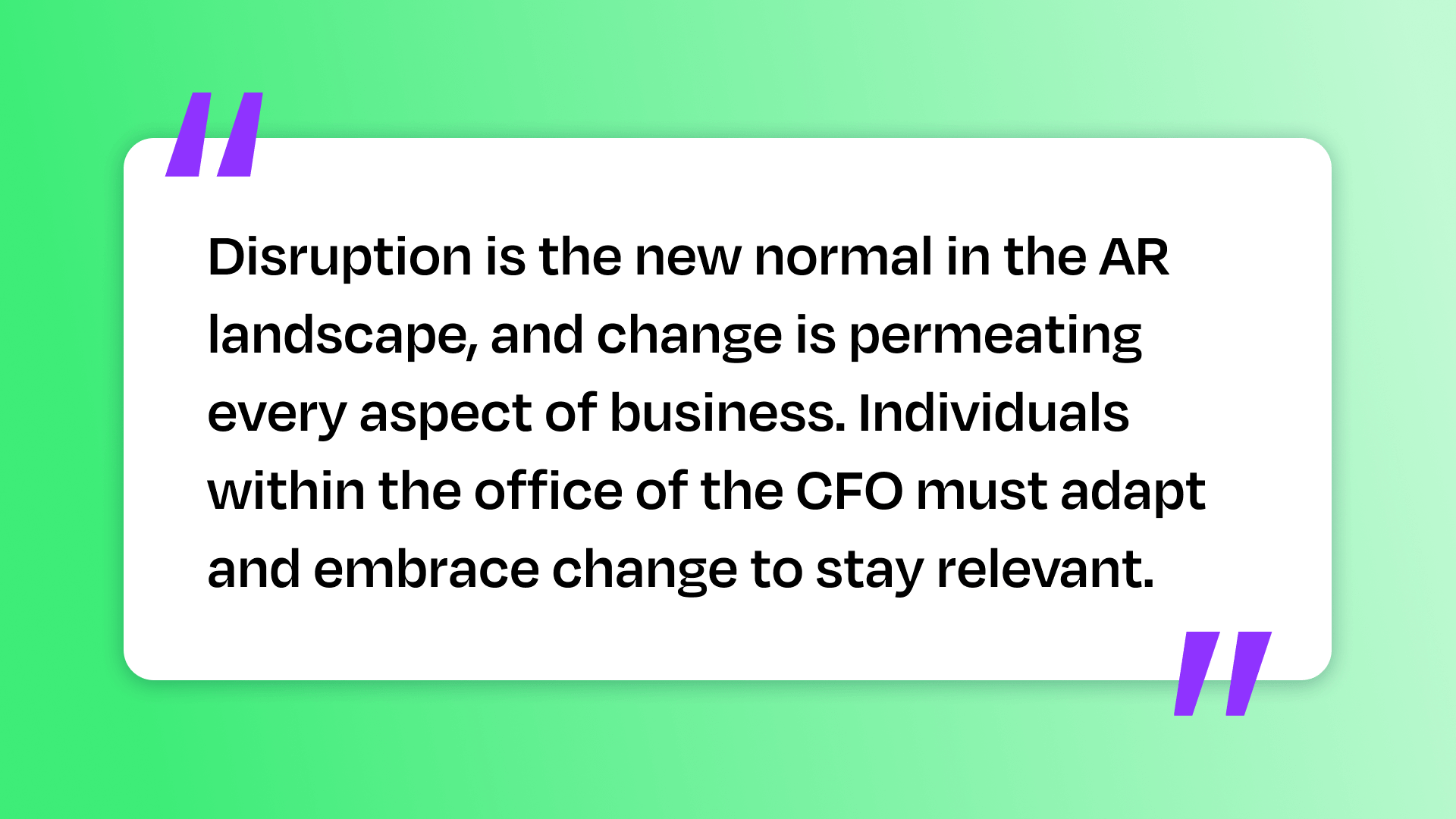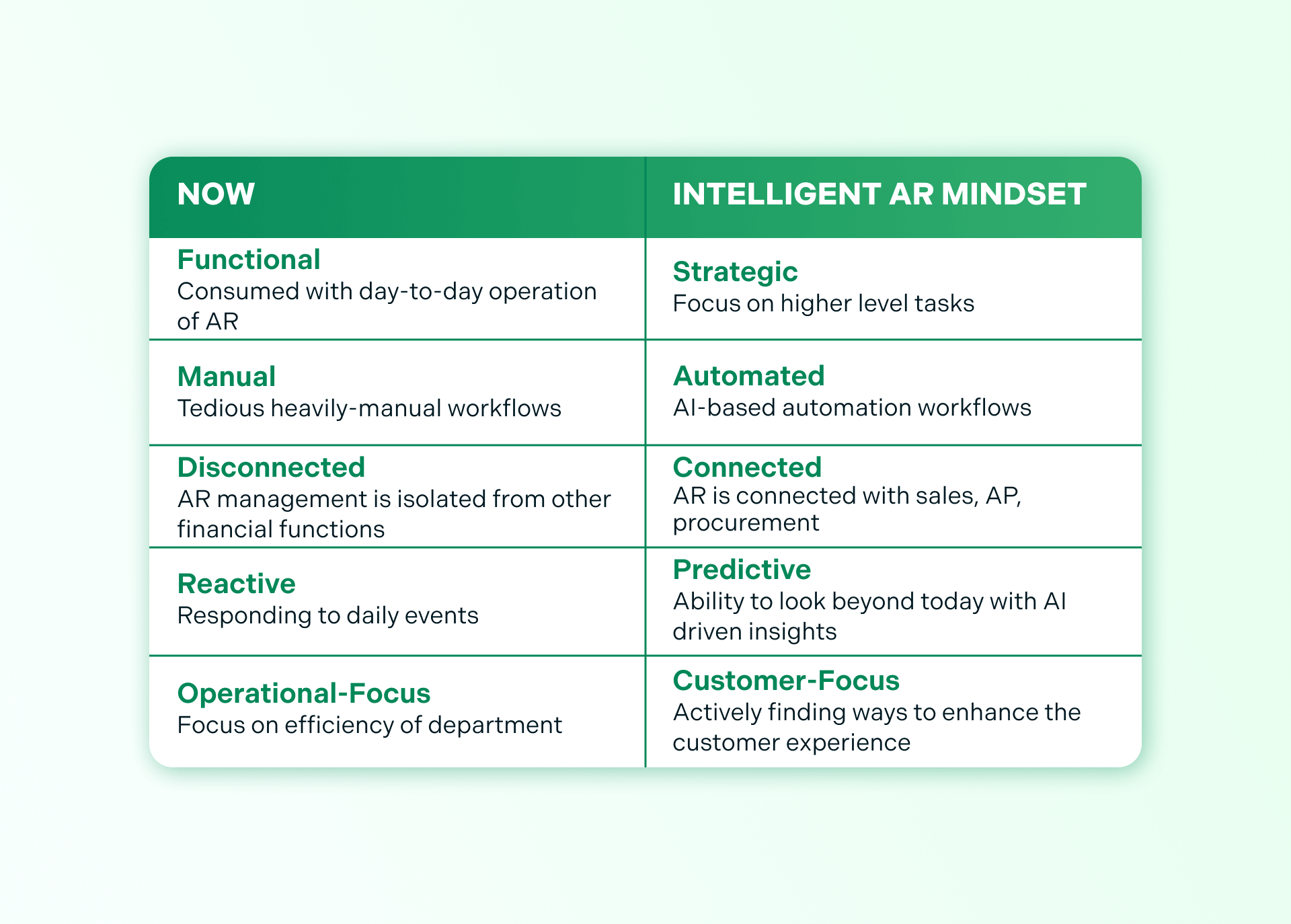This post was originally published in August 2023 and was updated in August 2025 with additional information on the evolving role of the CFO.
Be prepared to adapt, innovate, and thrive in the face of disruption.
The role of the Chief Financial Officer (CFO) is undergoing a transformative evolution. As businesses face unprecedented disruptions and dynamic challenges, CFOs must be prepared to adapt, innovate, and thrive amid uncertainty.
Recognizing the importance of understanding this shifting landscape, a 2023 survey commissioned by Billtrust and conducted by IDC sought to gather insights from global finance and accounting professionals regarding the state of accounts receivable (AR) in today’s dynamic environment.
In this article, we will explore the discoveries of this survey together with guest speaker Kevin Permenter, the Research Director of Financial Applications at IDC.
The changing landscape of CFOs
According to Permenter, the office of the CFO is currently experiencing a rapid transformation and expansion. While cash management and forecasting remain strategic priorities, CFOs are increasingly focusing on supply chain finance, insurance, and commodities.
This observation is supported by the findings of the survey. “When we asked about the impact of the impending economic downturn and prevailing uncertainty, a striking 90% of respondents affirmed that the importance of the CFO within their organizations had been significantly elevated,” says Permenter.
This recognition highlights the critical role CFOs play in navigating through challenging times and underscores the increasing significance placed upon their expertise and strategic contributions.
Organizations are placing a heightened focus on their cash management, specifically examining their order-to-cash process. 44% of survey participants have already implemented significant changes to their order-to-cash process in the past 24 months, particularly in payment management (52%), invoicing and billing (46%), and order and credit management (42%).
The increasing volume of data, as a result of these ongoing changes, is inundating CFOs, propelling their transition into the role of Chief Data Officer. As Permenter highlights, CFOs are now tasked with handling larger and more frequent amounts of data than ever before. This shift positions CFOs as the go-to individuals for various aspects, including Diversity, Equity, and Inclusion (DEI), IT infrastructure enhancements like ERP redesign, sustainability initiatives, and even talent management. In essence, CFOs have become the central nexus of data.
At the same time, many financial leaders are confronted with the challenge of working with the same, limited resources and outdated, manual order-to-cash processes. In that sense, the role of finance as a catalyst for overall company performance cannot be understated.
Read the blog → Defining the new role of the CFO

The State of AR
One of the major findings in the IDC survey is that the majority (60%) of organizations have immature or inefficient AR processes. Many are still struggling to achieve a truly connected order-to-cash process, with only 15% of respondents reporting real-time data integration. Among larger companies (5,000+ employees), results are even worse, with less than 10% having some sort of connected process. This highlights the critical need for a unified AR platform that centralizes data and workflows.
The prevalence of manual processes continues to dominate, directly impacting businesses’ bottom lines, as agreed upon by the majority of survey respondents. In fact, 94% of participants acknowledged that manual order-to-cash processes would have negative effects on their financial performance.
“94% of respondents think that manual order-to-cash processes have a negative impact on the bottom line of their business. The findings in the survey indicate a real urgency to invest in modernizing order-to-cash processes and optimizing the back office functions of the CFO.”
These challenges within the modern order-to-cash process primarily stem from outdated legacy systems. Multiple and disparate data sources, such as ERPs, bank lockboxes, commerce sites, and spreadsheets, hinder CFOs from accessing timely information.
Moreover, manual and repetitive tasks like cash and check payment reconciliation, as well as invoice resending, not only consume substantial time but also introduce errors that negatively impact the customer experience.
The need to revamp major aspects of your order-to-cash process
The order-to-cash process requires a significant overhaul to address the challenges at hand. Respondents have identified key drivers for change, including the pursuit of enhanced productivity and efficiency (32%), improved customer experience through accurate billing and convenient payment options (22%), and increased visibility into cash flow (18%).
CFOs face the daunting task of providing real-time answers to overarching questions. However, accurately determining cash or liquidity in real-time can prove exceptionally challenging for complex companies.
Without a major revamp of the order-to-cash process, achieving this feat is nearly impossible. Respondents strongly agree, with the majority (77%) recognizing that digital transformation across the entire order-to-cash process is crucial for their organization’s survival.
Benefits of deploying a modern order-to-cash process
Revamping the order-to-cash process can yield numerous advantages. Among these benefits, gaining deeper insight and intelligence into cash flow within the business, identifying areas where cash is trapped, and forecasting cash positions stand out.
“The job of CFO is quickly expanding to include the role of Chief Fortune Teller, adding new levels of stress to the job. To become effective Chief Fortune Tellers, CFOs need data-driven solutions that enable them to perform analytics and confidently build forecasts.”
Equipped with these valuable insights and real-time data around cash management, financial leaders are empowered to identify strategic trends and exert a tangible influence on key performance indicators. This enables them to make informed decisions that have a significant impact on the organization’s financial outcomes, and ultimately enhance overall cash flow.
Looking to the future
Despite the notable disruptions witnessed, there is a prevailing expectation of even more significant disruptions looming on the horizon. This anticipation of future disruptions is compelling businesses to adopt a more assertive stance when it comes to managing their accounts receivable.
“Having a firm view of the order-to-cash process is essential. With better intelligence, you’ll be able to be more agile and be prepared for any future disruption.”
Integrating AR functions in holistic apps
Vendors operating in this space already seem to have gotten the message. Permenter: “You are starting to see connectivity features, APIs, analytics, etc., as real differentiators for vendors. CFOs are in a bind. They are having to deal with more data from more places than ever before, and they have to do more with it, in more detail.”
AR software vendors have also started to rise to the challenge of integrating accounts receivable (AR) functions seamlessly. In recent years, there has been a noticeable trend among vendors towards convergence in the order-to-cash space. These AR software vendors are working to bring more holistic applications to the market. End users are the big driver here: they want continuous workflows in their order-to-cash process.
This convergence is evident through the occurrence of mergers and acquisitions, facilitating the integration of accounts receivable (AR) with other essential functionalities. These include payments, financing, billing, reporting, and treasury. Moreover, the convergence extends beyond AR and encompasses other areas such as accounts payable (AP) and sales.
For AR software vendors, it is imperative to prioritize the development of platforms that excel in data management and connectivity features. The focus should be on creating systems that effectively handle and integrate diverse sets of data, with an emphasis on stringent data security measures.
Transparency is key
For suppliers on the lookout for an AR software vendor, transparency is key in the supplier-vendor relationship. Vendors should have a product plan and deliver on roadmap promises, keep communication lines open, provide updates and ensure the ecosystem meets its commitments. It’s also about engaging end users, assisting with adoption among users and supporting customers’ success, helping them achieve their business outcomes.
Order-to-cash ultimately relies on people
The order-to-cash process is primarily about people, involving not only employees but also customers. Recognizing the significance of this human element is essential. The impact of employee and customer satisfaction on organizational success cannot be understated.
“54% agree that the lack of order-to-cash modernization has had a negative impact on the ability to attract and retain financial employees. 30% of respondents characterize order-to-cash employee turnover rate as high or extremely high.”
Permenter: “You can draw a straight line between unhappy AR employees and poor customer satisfaction. For financial leaders, this entails the requirement of increased investment in the identification and automation of lower-level tasks. This is necessary to alleviate the frustrations experienced by financial teams in their daily work. It also frees up time for employees to focus on customer needs, and not processes.”
Read the blog → The changing role of finance in 2025
Shifting to an intelligent AR mindset
Traditionally, accounts receivable (AR) has been viewed as a reactive and administrative process. However, with advancements and investments in technology and the growing availability of data, CFOs should start embracing an intelligent AR mindset that leverages automation, analytics, and insights to optimize cash flow, improve customer relationships, and drive financial performance.
This shift necessitates the integration of more technical skill sets within finance teams, including proficiency in new data techniques and data hygiene practices.

Incorporating AR software automation tools and technologies like AI, machine learning, and APIs is a fundamental aspect of embracing the intelligent AR mindset, leading to a transformed order-to-cash process.
Move beyond basic tools and embrace technologies like Agentic AI to handle complex tasks autonomously. With an AI assistant like Billtrust Autopilot, finance teams can get instant answers to cross-functional queries, manage exceptions, and optimize procedures without manual intervention, transforming the entire order-to-cash process.
As Permenter summarizes, modernizing the order-to-cash process is all about streamlining the journey from contract to cash, reducing processing time. Embracing these automation technologies not only improves efficiency but also garners enthusiasm from employees and customers alike. After all, who wouldn’t want to be a part of this compelling narrative?









